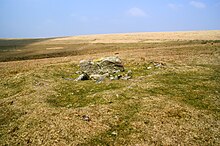You can help expand this article with text translated from the corresponding article in German. (May 2014) Click for important translation instructions.
|
| The examples and perspective in this article may not represent a worldwide view of the subject. You may improve this article, discuss the issue on the talk page, or create a new article, as appropriate. (May 2014) (Learn how and when to remove this message) |


A kistvaen or cistvaen is a tomb or burial chamber formed from flat stone slabs in a box-like shape. If set completely underground, it may be covered by a tumulus. The word is derived from the Welsh cist (chest) and maen (stone). The term originated in relation to Celtic structures, typically pre-Christian, but in antiquarian scholarship of the 19th and early 20th centuries it was sometimes applied to similar structures outside the Celtic world.

One of the most numerous kinds of kistvaen are the Dartmoor kistvaens. These often take the form of small rectangular pits about 3 ft. (0.9 m) long by 2 feet (0.6 m) wide. The kistvaens were usually covered with a mound of earth and surrounded by a circle of small stones. When a body was placed in the kistvaen, it was usually lain in a contracted position. Sometimes however the body was cremated with the ashes placed in a cinerary urn.
Kistvaens and Celtic saints
Kistvaens are also found associated with holy sites or burial places of early Celtic saints, who are often semi-legendary. Saints associated with kistvaens include Callwen daughter of Brychan, Geraint, Begnet, and Melangell. Foundation remains of stone slab- or gable-shrines, or the cella memoriae of Mediterranean origin, may sometimes have been misunderstood in an earlier era of scholarship as a kistvaen, and the subject is complicated by this "woolly nomenclature."
See also
- Dolmen, a type of above-ground burial chamber
References
- Cyril M. Harris, Illustrated Dictionary of Historic Architecture (Courier Dover Publications, 1983), p. 118 with illustration online.
- S. Baring-Gould and John Fisher, The Lives of the British Saints (London, 1908) p. 67 online and vol. 3, p. 51 online
- In the quoted passage incorrectly identified as St. Benedict; Joseph P. O'Reilly, "Notes on the Orientations and Certain Architectural Details of the Old Churches of Dalkey Town and Dalkey Island," Proceedings of the Royal Irish Academy 24 (1903), p. 196 online.
- Nancy Edwards, "Celtic Saints and Early Medieval Archaeology," in Local saints and local churches in the early medieval West (Oxford University Press, 2002), pp. 234ff., with photo. Scholars may describe the kind of structure called a "kistvaen" rather than using the term itself.
- Ulster Journal of Archaeology 63 (2004), p. 144.
External links
- Dartmoor tomb raiders
- Dartmoor Kistvaen Archived 30 June 2017 at the Wayback Machine